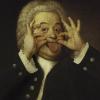All Activity
- Past hour
-

Jouskas (looking for feedback)
Henry Ng Tsz Kiu replied to Fruit hunter's topic in Orchestral and Large Ensemble
Hello @Fruit hunter! The mallets at the opening is a nice touch. Always like your percussion choice since you are a percussionist yourself. I think the whole music is energetic with some good contrast between those energetic passages, and very colorful. Thx for sharing! Henry -

Paper Swan - Isen Lark - Cinematic Piano Solo
Henry Ng Tsz Kiu replied to Isen Lark's topic in Piano Music, Solo Keyboard
Hello @Isen Lark! Welcome to the forum! That's a soothing sad music reminds me of Richard Clayderman. It's lovely, maybe you can provide some contrast by modulating to a different key in the middle section out of G minor. But the whole music is enjoyable, nice ending as well! Would be great if you can also provide the score of your music. Thx for joining and sharing your music here! You can also visit other membets' posts and possibly leave reviews on them. Henry- 1 reply
-
- cinematic
- cinematic music
-
(and 1 more)
Tagged with:
-
Hi @pateceramics! The beginning is really dark with a dark key and dissonancnes. I like that in the first few pages the dissonances are still remained until the really bright C major section, and after that it's all God's glories. I also like how the four voices interact with imitations and call and response. Thx for sharing! Henry
- Today
-

What Is Your Current Musical Project?
AngelCityOutlaw replied to AngelCityOutlaw's topic in Composers' Headquarters
Pop instrumentation can be quite literally anything, but is most commonly based around a "band" rhythm section. Drumkit, bass guitar, and usually some chordal instrument like a keyboard guitar. Drums are very simple in most pop tunes. The simple "four on the floor" pattern is in almost every song. Kick drum on beat 1 and 3, snare on 2 and 4. - Yesterday
-
PeterthePapercomPoser started following Paper Swan - Isen Lark - Cinematic Piano Solo
-

Fugue XI in F major for 3 voices
Luis Hernández replied to Wieland Handke's topic in Piano Music, Solo Keyboard
It sounds great. I think the theme is very original, and when that happens in a fugue, it's much easier to follow the developments. To my taste, but this is just my personal opinion, the tempo is perfect. Because when there are fugues with dense textures and the movement is very fast, I think you lose a little bit of that sense of knowing where things are going aurally. The layout of the video is great. And the score is very, very detailed (sometimes I think some things could be simplified), and that's a plus. -
Sounds good. But here are a few observations: In my opinion, there is little use of inverted chords. So much movement of the bass in root notes is very strict and not very melodious (it is not in keeping with the counterpoint style). There are some strange twists in some modulations. In measure 7 you have Bm - E.... and then Gm!! It's true that Gm - C - modulates to F. But that jump from E to Gm is harsh in this context. Something similar happens in bar 11: F - Em(b5) -- F# (b5) - B... to go to Em. These are progressions that appear with sudden changes and make it sound very strange. I'm not saying that this can't be written, but in this absolutely tonal context, I think it's out of style. If you do this in a contemporary language, it could work.
-
Excellent! I love the way your ARJUNA theme skips along rhythmically in the violin part; the whole piece has such a lighthearted feel to it. I would have liked a little more bold variety to the repeated wind blows fair, wind blows cold theme that we see in the violin at measure 62, since it comes up several times. It feels like you could have pushed the harmonic surprise there a little more in those places, but I know you said you were also trying to simplify your ideas in this piece. Excellent job keeping both parts varied for interest and letting them interact with each other in diverse ways that will let the musicians enjoy bouncing off each other's musical ideas. This seems very fun to play! I hope you'll enjoy it!
-
Henry Ng Tsz Kiu started following Paper Swan - Isen Lark - Cinematic Piano Solo
-
Isen Lark started following Paper Swan - Isen Lark - Cinematic Piano Solo
-

Paper Swan - Isen Lark - Cinematic Piano Solo
Isen Lark posted a topic in Piano Music, Solo Keyboard
Hi! My name is Isen Lark, and I'm happy to share the first composition I decided to publish on Spotify: "Paper Swan". The paper swan sat by the old piano, its wings curled from time and dust. Somewhere, a song played softly—one we used to know. The notes wavered, like the swan might lift off, but never did. MIDI.mid- 1 reply
-
- 1
-

-
- cinematic
- cinematic music
-
(and 1 more)
Tagged with:
-
Isen Lark joined the community
-
PeterthePapercomPoser started following The Grasses
-
Henry Ng Tsz Kiu started following The Grasses
-
This piece contrasts an excerpt from Walt Whitman's preface to Leaves of Grass with 1 Peter 1:24 "All flesh is as grass...", otherwise known as the best part of the the thoroughly excellent Brahms Requiem. Whitman's text urges us to think for ourselves and do the right thing, letting our lives speak for our morals. The biblical passage reminds us that our lives are beautiful, but short, lending urgency to Whitman's words. There is only so much time. “…read these leaves in the open air every season of every year of your life, re-examine all you have been told at school or church or in any book, dismiss whatever insults your own soul, and your very flesh shall be a great poem and have the richest fluency not only in its words but in the silent lines of its lips and face and between the lashes of your eyes and in every motion and joint of your body...” -Walt Whitman For all flesh is as grass, and all the glory of man as the flower of grass. The grass withereth, and the flower thereof falleth away: 1 Peter 1:24
-
I like this so much! His poetry is so evocative of a time and place, while simultaneously the speaker could be someone you pass on the street today. The rocking rhythm of your piano accompaniment feels appropriate to an evening spent lying on the carriage roof, soul twirling along with the smoke. Your harmonies around 1:10 work very well to inject a little melancholy and mystery to "pourquoir me comprenez-vous pas?" You do an excellent job of turning your musical language to follow the narrator's emotional journey, while still producing a cohesive piece. Bravo!
- Last week
-
Marius_ started following Echoes of Flame - Concert Band
-
Echoes of Flame - Concert Band
Marius_ replied to NicholasG's topic in Orchestral and Large Ensemble
Hey Nicholas, I like your piece a lot! It sounds epic, and you take your time with each theme, which makes it sound coherent and easy to listen to. I don't have any experience writing for large ensembles, so I thought I'd only give feedback on your brass writing (I play the trumpet myself). First of all, in bar 21 consider raising the second trumpet an octave. That will make it easier for the first trumpet to hit his note: it is easier to play when being 'carried' by the rest of the section - and that two-octave gap is to large to give that effect. (As written it will sound like a solo instead of team work.) My teacher used to say: 'Trumpet players are surfers. We surf on sound.' At certain points in the score you write divisi for the trumpets, horns and first trombone - but you assigned three players to each part (in the preface)!! Which of the two voices should get two players? Either split up in three parts or make a note in their score, telling them what to do. But also consider that your brass section is humongous (A dozen players on trumpet and horn): You can change the parts to avoid all divisi. E.g. after bar 102 you could give the trumpets the root and fifth and the horns the root and third. In Musescore this will sound just the same, but when played by a real orchestra all voicings sound distinctly different. Not having divisi also is less confusing - especially if your players don't get (many) rehearsals. Btw that 1.5 octave jump in bar 106, first trumpet, looks really scary... Lastly, from that same bar 106 your trumpets and horns are playing fortissimo - which basically means 'as loud as possible'. Therefore the four (!) crescendo's you write later in the part won't have any effect... Either tell them to take back before each crescendo, or don't write them at all. That'll conclude my oddly-specific-feedback : ) . I should tell you again - I'm no pro at all, and your writing already is really good. Don't take this as harsh criticism: I'm just better at pointing out imperfections than giving elaborate compliments :)). I really enjoyed listening to your piece! Kind regards, Marius -
PeterthePapercomPoser started following Echoes of Flame - Concert Band
-
Henry Ng Tsz Kiu started following Echoes of Flame - Concert Band
-
NicholasG started following Echoes of Flame - Concert Band
-
Hello, I just finished a cinematic Grade 6 piece for concert band and I'd like to share it with everyone! I am very proud of it especially as a 16 year old composer. The story of the piece is a fire god of which has been long forgotten, he then awakes and imposes his wrath on humanity. While this is happening cultists gather to worship this fire god. There is no heroic conclusion, the god wins.
-

New Waltz in C Major for String Quartet or Piano Quintet
danishali903 replied to Chemathmusician0510's topic in Chamber Music
Just to clarify, I'm not saying the composition itself is basic. It's the string writing that's "basic"...as in there seems to be these defined roles akin to a 4 part choir (1st violin = soprano, 2nd = alto, etc.) -
Very charming! I'm definitely getting a Beethoven/Brahms vibe from this movement. The modulation to D major in the exposition is unexpected, but it works! The 2nd ending/intro of the development is a little odd. I think a little more motion from the piano into bar 102 would make the transition smoother (suggestion: maybe the violin motif in 102 could be played in the piano bass line at the 2nd ending). Another minor suggestion (and this one is just a personal preference)...3 before the end, maybe have the violin play a pizzicato B-flat major chord (maybe without the piano). The violin writing is very idiomatic for the instrument. The piano writing seems fine to me...though not a pianist myself.
-
PeterthePapercomPoser started following Solo de lune for (my) voice and piano
-
Hello Here is another piece of the cycle "a la lune" according to Jules Laforgue. I didn't count. I must be at 4 or 5 on the same theme. Here is a kind of little song that looks like a waltz. Sweet bitter, of course, since it is lost love... Translation in the video in subtitles. Thank you for your criticism!
- 1 reply
-
- 2
-

-
I just never thought of it lol, as I thought all sonatas for violin and piano are called Violin Sonatas anyways but look like I'm wrong. I did put some slight melodic emphasis for the violin as this is Arjuna's instrument to play, and I would love the instrument to sing beautifully. Thx for your review! Henry
-
Hey Mike! Yeah I'm just able to sneak in some pentatonicism in this otherwise normal classical/romantic movement. I am learning how to write simpler and lighter music while still maintaining the flow and effectiveness, because it's not things I have done in the past few years. Yeah I don't wanna explore too much here, maybe in the variation 4th mov there's more! Thx for your review! Henry
-
Hi Peter! The Nimrod theme is 10 times better than mine lol! I love that variation very much! Well I don't care whether a friend is known through real life or internet. Arjuna is definitely much closer than many people I know in real life. I won't write a piece for someone I don't treasure. Yeah I just try to for light mood and simple style here, something enjoyable and not too difficult. Honestly I quite enjoy composing this piece after the Sextet since that one takes tons of efforts. Thx for your review Peter! Henry
-
Myths of the Deep Woods
Fruit hunter replied to BipolarComposer's topic in Orchestral and Large Ensemble
Can I have the score to this? This way I can give more detailed feedback and also talk about orchestration. -
Winter Road Drive
Fruit hunter replied to EmotionallyChargedMusic's topic in Incidental Music and Soundtracks
The chord progression sounds very similar to Vivaldi‘s winter concerto for the first movement. Same thing with the rhythm, but articulated differently with more aggression. Also, there is some twinkle sound. I don’t know if it’s a glockenspiel or glass bottles or literal icicles being played on. It sounds nice, but some are out of time unless if that’s your intention. -
Look in the description of video for performance notes. I also had attached a PDF of the score. Keep note that this is one of my shorter works and has been rushed so not a lot of effort had been put into this
- 1 reply
-
- 1
-

-
Violin Sonata in B-flat major, 1st movement: Allegretto grazioso
PCC replied to Henry Ng Tsz Kiu's topic in Chamber Music
Would the title Sonata for violin and piano be more appropriate? We say violin sonatas informally, but the compositional weights seems balanced at least to a certain extent imo -
Violin Sonata in B-flat major, 1st movement: Allegretto grazioso
chopin replied to Henry Ng Tsz Kiu's topic in Chamber Music
A very light, and elegant Mozart / Beethoven-esqe influenced piece. But now that I listened to this more closely a second time, this sounds more Beethoven. I noticed you kept things a lot more simplistic with this composition. The simplicity makes it easier to follow the story. For example, I noticed you referenced your sextet's pentatonic themes in a few places too which was a nice touch, particularly here: 1:38 3:28 5:27 6:27 Your key changes from the major to parallel minor also made me think a lot of Beethoven's key changing style. For example, at 1:07, this is a prime an example of some key changing techniques I hear in Beethoven's concertos. I loved 3:40 - to 3:53. This was a section that could have been used to segue into a completely different theme. But I suppose you didn't want to venture too far off from the main theme of this piece. Either way, great piece, fun traditional classical harmony and nice references to your sextet.


